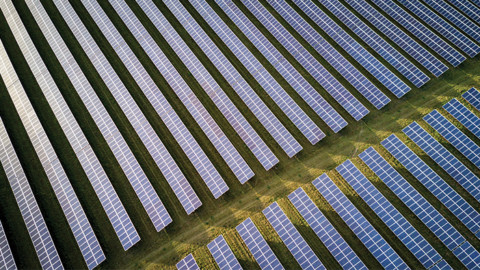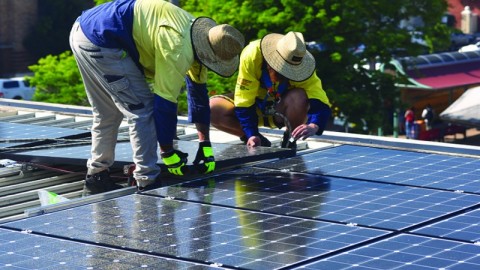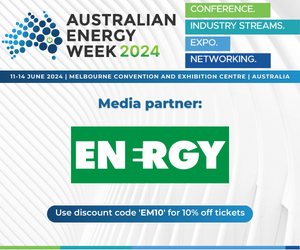In Germany, the world’s first vehicle-to-grid technology has been unveiled, essentially creating a mobile battery than can move around and inject energy back into the grid where it is required. We take a closer look at the technology, released in October, and look at the potential implications for the energy market.
An important milestone on the road to emission-free energy and mobility has been achieved in Hagen, Germany, with a team of engineers successfully qualifying an electric vehicle against regulatory requirements for primary power regulation.
This is the first time an electric car has been officially approved as a power plant for the German energy market in a vehicle-to-grid (V2G) scenario – the most sophisticated means of grid stabilisation. This is a major breakthrough in the establishment of a new form of energy storage and transmission in Germany, and perhaps even around the world.
The breakthrough has come courtesy of technology company The Mobility House (TMH), energy supplier ENERVIE, transmission system operator Amprion and car maker Nissan.
With the Nissan Leaf, and an innovative charging and energy management technology, the car can be integrated as a regulating reserve for the German electricity grid.
To meet the desire for a transition to decentralised energy generation from renewable sources in Germany, new and innovative solutions for stabilising the electricity grid are necessary. The increasing use of renewable energy leads to fluctuations in the grid, which must be initially balanced by primary regulation, able to prevent impending power cuts at a second’s notice.
Electric cars such as the Nissan Leaf, with integrated bidirectional charging technology, could play an important part in this. With its CHAdeMO charging connector, the Leaf is able not only to extract power from the grid and store it in its traction battery, but, if necessary, also to feed power back.
The bidirectional chargeability of Nissan’s electric car is the foundation for its integration in the pilot project at the ENERVIE site in Hagen, Germany. In combination with innovative, intelligent charging and energy management technology from TMH, the charging and discharging processes can be controlled and monitored.
“We are pleased that Mobility House technology has been approved for the most challenging and important product of the German power supply system,” said Thomas Raffeiner, CEO and founder of The Mobility House (TMH).
“We strongly believe in an emission-free future,” says Guillaume Pelletreau, Vice President and Managing Director, Nissan Center Europe. “Accordingly, we are also very proud that the Nissan Leaf has, as the first electric car ever, been approved as suitable for stabilising grid frequencies. Leaf batteries could make an important contribution to energy transition in Germany and a sustainable
future.”
As one of four Transmission System Operators (TSOs) responsible for the transmission of power in Germany, and thus charged with the stability of the power grid, Amprion is a supporter of the ambitious V2G project. The TSO has defined the technical and regulatory requirements for prequalifying a mobile battery storage unit for the market for primary regulation; and Amprion has now approved the Nissan Leaf, in combination with the control system from The Mobility House, as suitable for this function.
“We are proud to be the first in Germany to prequalify an electric car for primary regulation,” said Andreas Walczuch, Head of System Services and Energy Market at Amprion. “This innovation shows us that electric cars may have a part to play in securing system stability.”
Erik Höhne, Executive Spokesman of ENERVIE Group in Hagen, said: “By providing the infrastructure for the project on site, ENERVIE has extended its commitment to e-mobility as an innovative partner for industry, commerce and the people in the region by a further facet.”
Sustainable energy using V2G
Thanks to electric mobility, cars can become an active element of the power grid. This is a clever and cost-effective way to integrate renewable energy such as solar and wind power into the grid, and to smooth out peak loads.
On average, private cars sit idle for 23 hours a day, barely driving more than 40km. For these reasons, battery-powered cars are ideal for use as electricity caches. To accomplish this, electric cars need to operate using V2G technology: in other words, they need to be able to both take in and give off electricity.
This new future for the energy world might seem a long way off, since appropriate vehicles and products are not yet widely available.
But TMH in Munich is taking the first steps by conducting pilot projects, many of which have proven that V2G offers economic and practical advantages to everyone involved: energy providers benefit because they can sell more renewable energy; network operators benefit because they are spared expensive network expansions; and end customers benefit because they can earn money with their electric cars while they are parked.
In another unique benefit, car owners don’t need to worry about the batteries of their electric cars wearing down prematurely due to their side job as temporary power caches. In fact, quite the opposite is the case: the research of TMH in collaboration with the Technical University of Munich has indicated that this uniform load distribution acts like a kind of battery massage, keeping the usable life of a battery stable and even extending it in particular circumstances.
Since 2012, TMH has been testing the technologies that will make V2G fit for everyday use. At first, the focus was on optimising the charging process for electric cars and benefiting from price fluctuations on the electricity market. In a pilot project with Renault, TMH developed smart charging software that takes energy from the grid when it is cheaper, based on the driver’s needs. On average, charging costs can be reduced ten to 15 percent. Today, this smart charging process is a core component of the charging and energy software offered by TMH.
The next step was to find another way to get the power out of the car battery so it can be used in households. In 2015, TMH successfully integrated a Nissan electric car into the building’s power grid at the company headquarters in Munich for the first time and used this car to supply power to the office. Since then, a whole lot of espressos have been powered directly by the electric car in the
parking garage.
A similar project is currently underway at the research centre of the car manufacturer Honda in Offenbach, where TMH is testing bidirectional charging. Here, a system consisting of a V2G-enabled charging station, an electric vehicle and the building’s power load is used to optimise energy consumption. This project aims to increase personal use of solar power and reduce energy costs.
One of the most exciting V2G projects is currently being conducted on the island of Porto Santo in the Portuguese archipelago of Madeira. In the middle of the Atlantic, where diesel generators were used in the past to produce the required electricity, the aim is to create a mostly self-sufficient and sustainable energy system consisting of wind turbines, photovoltaic cells, stationary storage and
electric cars. The first 22 Renault electric cars, two of which are V2G-enabled, are already operational, helping to make the power grid of this island with 5000 inhabitants independent from the costly supply of diesel.
In another project conducted in Germany with the network operator Tennet and Nissan, electric car batteries are used to optimally feed renewable energy into the grid and to ensure that renewable energy is not deactivated due to network congestion problems between energy-rich northern Germany and the electricity-hungry south. Power demand is very high in the morning and evening, particularly in southern Germany. The construction of a north-south line is under consideration to balance out these peak loads and bring wind power, which is abundant in the north, down to the south.
Another TMH project is currently investigating whether it makes more sense to rely on electric cars as power caches instead of building costly new lines. During hours with a lower electricity demand, for example at night and in the early afternoon, these vehicles in the south could easily take in lots of wind power from the north and store it temporarily without burdening the existing lines to their limits.
During peak load times in the morning, at around noon and in the evening, the electricity in their batteries would be used to cover the high demand directly where it is needed. This would require thousands of electric cars with suitable charging stations, but given the continually increasing numbers, it is only a matter of time before this proposal could become a reality.
Out of all of TMH’s projects, the most technologically demanding application on the energy market is the project in Hagen where the Nissan Leaf is being used to stabilise primary control power in Germany for the first time ever: this is the ultimate challenge in grid network stabilisation. It requires reliably balancing power fluctuations in real time within a matter of seconds. In the past, this task has mostly been accomplished by gas turbine power plants or pumped-storage power plants.
What sets this project apart is that electric cars can be used to earn cash through primary control power: network operators can bring in hundreds of millions in revenue every year from network stabilisation.
Customers should be excited: if electric cars are available for the same price as comparable petrol or diesel models in a few years, it may one day be possible to make money using a car as a power cache. Driving cars could potentially be about to become a whole lot cheaper – not to mention more environmentally friendly.


















